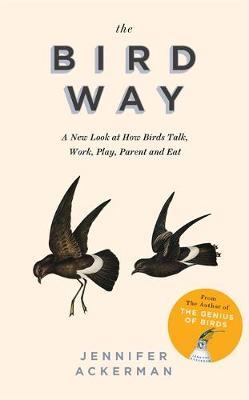The Bird Way

- The Bird Way by Jennifer Ackerman (Corsair, London, 2020).
- 355 pages, 17 line drawings.
- ISBN 9781472152909.
Despite the accent often being on identification, perhaps the real joy of birding is the time it gives for reflection, observing the creatures' behaviour and activities as days and seasons pass.
Ornithologists get to dedicate their working lives to such observations and the more they observe avian behaviour, the more complex and clever it is revealed to be. The last five years have seen what could be described as a revolution in studying bird behaviour, with one scientist suggesting that there are two ways to evolve intelligence: "the mammal way and the bird way". Jennifer Ackerman's well-realised task in this book is to relay just how different and advanced ‘the bird way' truly is.
There are currently more than 10,000 bird species – or ways of being – and Ackerman takes an up-close but pan-continental view of the latest research into how they mate, perceive and survive. The numerous examples are balanced in favour of Australasia – fittingly, as the continent was the cradle of passerine evolution and its initial main radiation – but the rest of the world gets a good look in, too.
The book goes into great and beguiling detail of many of the discoveries that have populated the BirdGuides news pages in recent years: Whistling Kites starting bushfires to force small animals into the open, Ravens shrieking as they 'play' by sliding down scree slopes, Kea stealing NZ$1,200 from a hapless Scottish tourist, the Western Gull tracked travelling at 60 mph later discovered to have been hitching a ride to the local landfill on a garbage truck. Add to this the shyness of Arabian Babblers having sex, hiding away from the eyes of the rest of their flocks, and White-winged Choughs kidnapping and murdering and all of human life is therein – in feathered form.
Ackerman also relays a quieter revolution by default: many of these secrets are being uncovered by female scientists, whose perspective is revealing aspects that pass under the radar of the male gaze. Birders are beginning to be familiar with the idea that female birds sing, but much of the work on this has been done by two women ornithologists, revealing that at least 1,141 species' females habitually sing. We also come across former astronaut Jessica Meir recording the submergence times of Emperor Penguins (up to 27 minutes!) and Jessica McLachlan translating the astonishingly wide vocabulary of Australian honeyeater alarm calls.
But it is impossible to list the panoply of behavioural disclosures rife in these pages. I strongly recommend you read it for yourself – everyone will gain a greater understanding of the breadth of ways of being a bird and be rendered breathless from the possibilities revealed.


